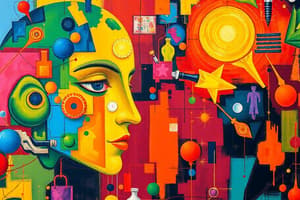Podcast
Questions and Answers
What was the main reason behind the introduction of Sustainable Development Goals (SDGs) by the United Nations in 2015?
What was the main reason behind the introduction of Sustainable Development Goals (SDGs) by the United Nations in 2015?
- To measure progress in technology advancements
- To address economic growth challenges
- To promote AI technologies
- To tackle extreme poverty, inequality, and climate change (correct)
How many Sustainable Development Goals (SDGs) were introduced by the United Nations in 2015?
How many Sustainable Development Goals (SDGs) were introduced by the United Nations in 2015?
- 12
- 17 (correct)
- 20
- 15
Which of the following is not a common area where AI technologies can assist in achieving the Sustainable Development Goals?
Which of the following is not a common area where AI technologies can assist in achieving the Sustainable Development Goals?
- Ensuring quality education
- Providing luxury services (correct)
- Promoting gender equality
- Ending hunger
What is the primary purpose of the specific targets and indicators associated with each Sustainable Development Goal (SDG)?
What is the primary purpose of the specific targets and indicators associated with each Sustainable Development Goal (SDG)?
In what year were Sustainable Development Goals (SDGs) introduced by the United Nations?
In what year were Sustainable Development Goals (SDGs) introduced by the United Nations?
What is one of the main benefits of using AI algorithms in the context of Sustainable Development Goals (SDGs)?
What is one of the main benefits of using AI algorithms in the context of Sustainable Development Goals (SDGs)?
In the realm of SDGs, what is a key challenge associated with implementing AI into society?
In the realm of SDGs, what is a key challenge associated with implementing AI into society?
How can AI contribute to environmental protection as mentioned in the text?
How can AI contribute to environmental protection as mentioned in the text?
What is one way AI fosters social cohesion in the context of SDGs?
What is one way AI fosters social cohesion in the context of SDGs?
Why is there a human capital challenge associated with AI implementation in society according to the text?
Why is there a human capital challenge associated with AI implementation in society according to the text?
Flashcards are hidden until you start studying
Study Notes
Artificial intelligence (AI) has been increasingly recognized as a powerful tool with potential applications across various aspects of sustainable development goals (SDGs). AI can help address global challenges related to poverty reduction, climate change mitigation, environmental protection, food security, health care, and education. In this article, we'll explore how AI is being used to support SDG initiatives, what challenges arise from its implementation, and examples of successful projects.
Overview of Sustainable Development Goals
The United Nations introduced the SDGs in 2015 after recognizing that economic growth was insufficient in addressing humanity’s most pressing problems such as extreme poverty, inequality, and climate change. There are 17 interconnected goals covering economic, social, and environmental dimensions. They aim to end hunger, achieve good health and wellbeing, ensure quality education, promote gender equality, reduce poverty, increase access to clean water and sanitation, improve affordable housing, promote sustainable cities, foster innovation, and more. Each goal has specific targets and indicators designed to measure progress over time.
AI Applications for Supporting SDGs
AI technologies have considerable potential to contribute to all areas of human endeavor, including those related to achieving sustainability. Some common ways AI assists with SDGs include:
-
Data Analysis: AI algorithms sort through vast amounts of data quickly, identifying patterns and making predictions based on new information. This helps governments, companies, and individuals make informed decisions about policies, investments, and daily choices. For instance, it could help farmers predict weather changes or analyze soil fertility levels, allowing them to optimize crop yields while reducing waste and pollution.
-
Efficiency Improvement: Machine learning models can spot inefficiencies in systems, suggesting improvements that may only become visible once analyzed by computer programs. For example, AI can enhance public transportation scheduling and routing strategies, resulting in more efficient travel times and reduced fuel consumption.
-
Innovative Solutions: AI can suggest novel solutions to complex problems. By analyzing historical data, it might identify alternative approaches that were previously untested due to their complexity or lack of funding. These innovations often lead to cost savings, improved services, and increased efficiency.
-
Fostering Social Cohesion: AI can facilitate communication between people who speak different languages, enabling cross-cultural understanding necessary for cooperation among diverse groups working towards collective objectives. Additionally, AI-powered recommendation engines suggest products or services tailored to individual preferences, helping users find items suited to their needs without having to physically search everywhere themselves.
-
Environmental Protection: AI can also play a role in protecting the environment. One notable project involves using drones equipped with thermal imagery technology to monitor deforestation, providing real-time alerts when forest clearances occur. Another project employs machine vision algorithms to detect signs of animal distress or injury within wildlife reserves, assisting conservation efforts.
Despite these promising developments, there remain significant challenges associated with implementing AI into society and meeting the needs of SDGs:
-
Privacy Concerns: As AI relies heavily on personal data collected from multiple sources, ensuring privacy remains key. Proper regulation must protect citizen rights yet allow analytics firms full access to datasets needed for analytical purposes.
-
Human Capital Challenges: Despite growing enthusiasm around AI capabilities, skilled professionals capable of managing complex AI systems are still scarce globally. This shortage threatens the ability of organizations to fully leverage AI technologies in pursuit of SDGs.
-
Cost Considerations: While automating certain tasks improves operational efficiencies, some argue that cutting labor costs may reduce GDP and tax revenues, ultimately exacerbating income inequality rather than resolving issues like poverty eradication. Governments need to consider the impact of labor displacement caused by advances in automation technology if they wish to keep pace with technological change.
Overall, despite the drawbacks, many experts believe that investing in AI will produce substantial benefits over time. However, any gains require appropriate investment in infrastructure, resources, education, and policy frameworks.
One example demonstrates the power of artificial intelligence applied effectively. 'The Great Green Wall', a program aimed at restoring degraded lands across Africa, has seen dramatic results thanks largely to satellite imagery analysis powered by machine learning algorithms. With insights gleaned from thousands upon millions of images, African nations now know where best to plant crops, conserve wildlife habitats, and prevent further desertification - making agriculture significantly more productive, minimizing its ecological footprint.
In conclusion, while challenges exist regarding the implementation of AI technologies to support SDGs, there exists tremendous potential for AI solutions to address pressing global concerns. To unlock this potential requires continued advancement in both technical competence and inclusive policymaking.
Studying That Suits You
Use AI to generate personalized quizzes and flashcards to suit your learning preferences.




